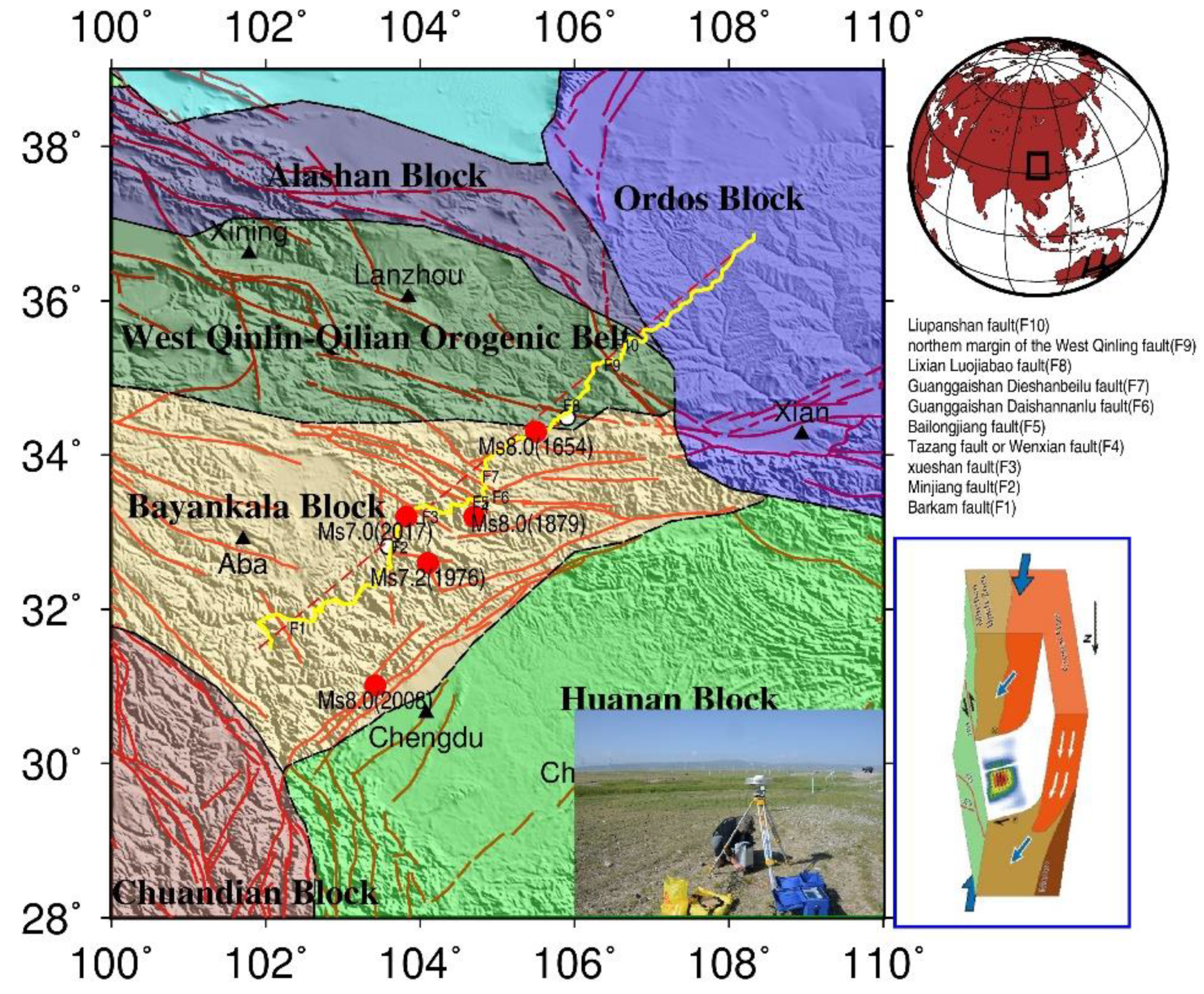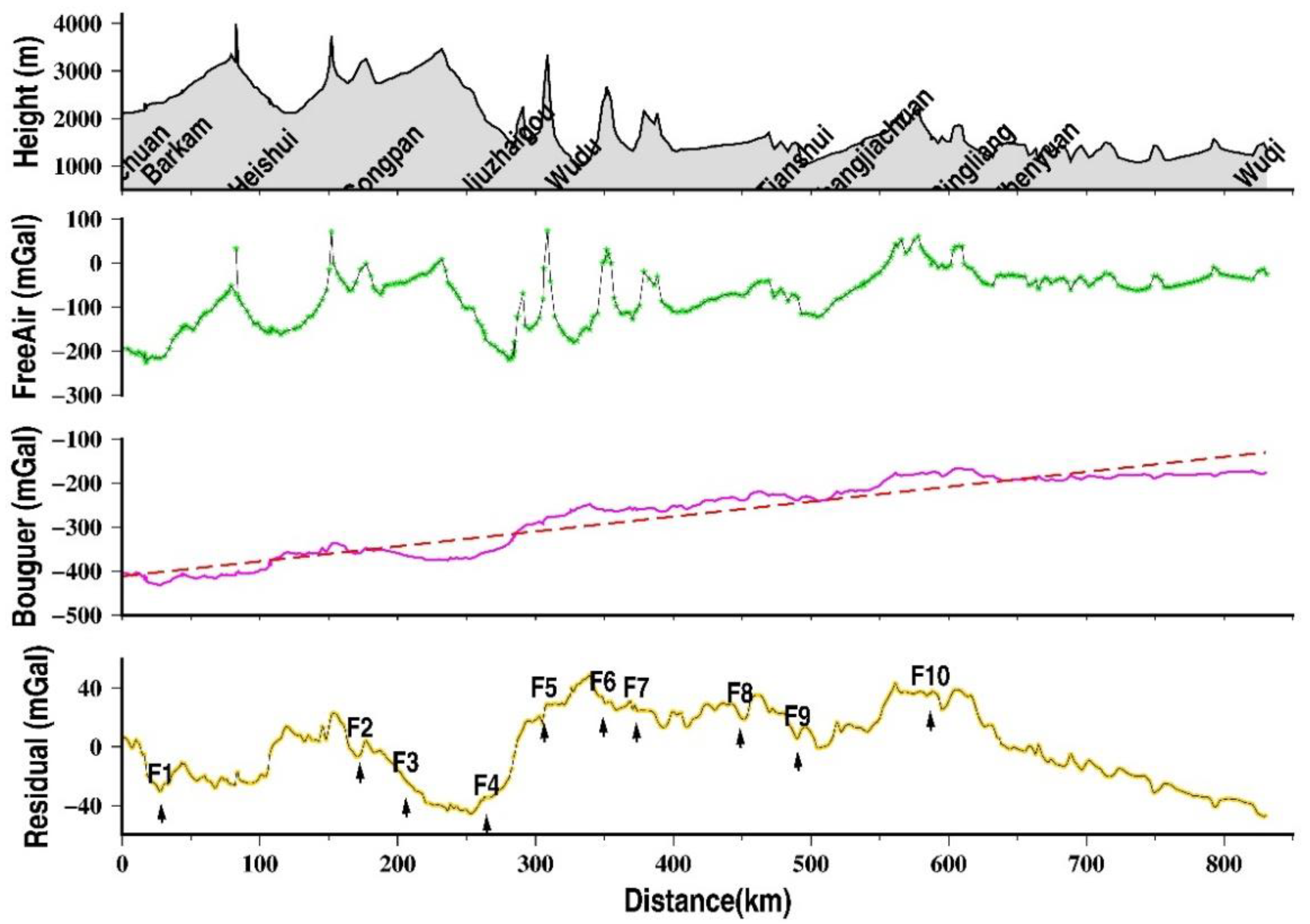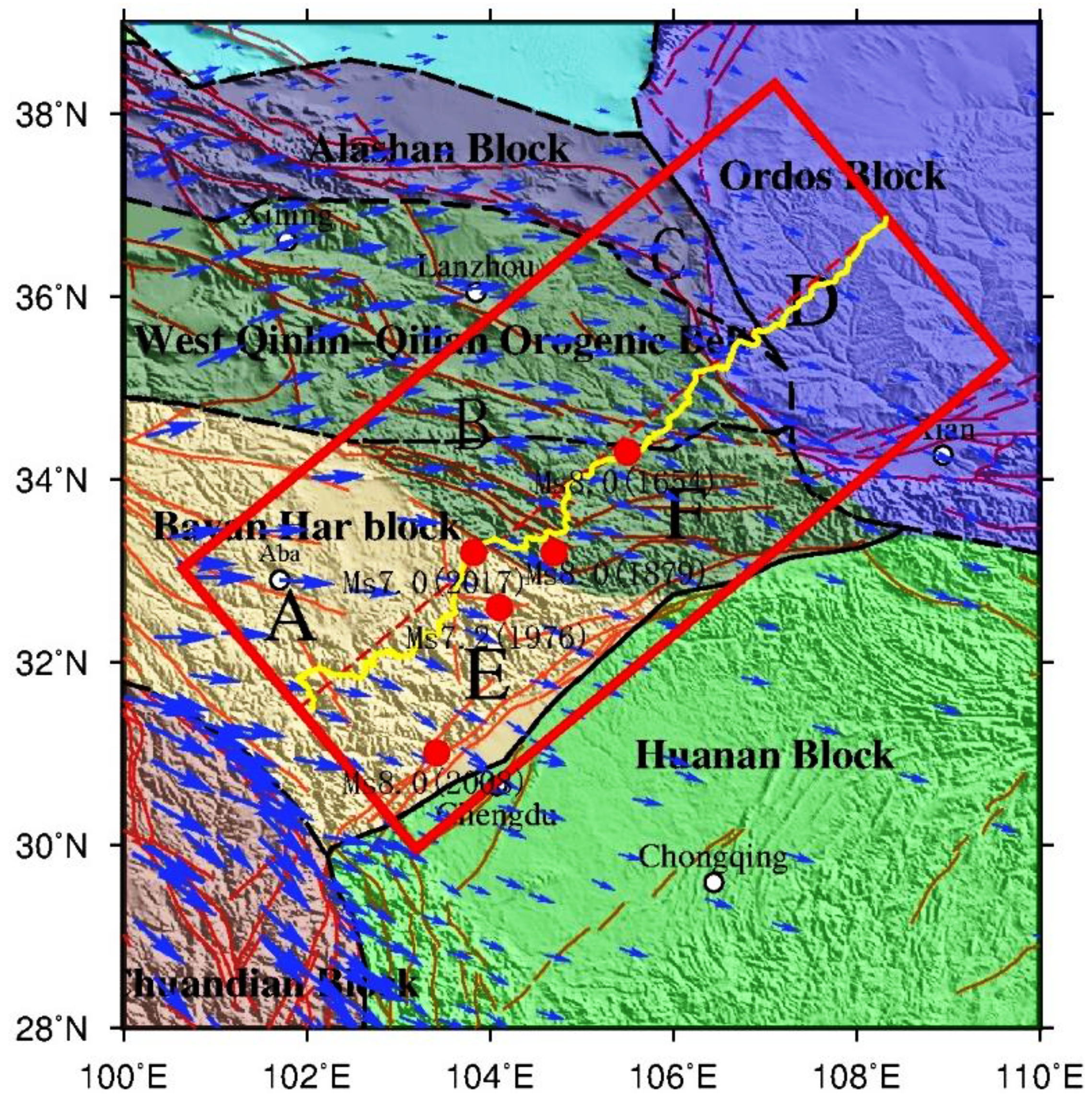Crustal Density Structure of the Jiuzhaigou Ms7.0 Earthquake Area Revealed by the Barkam–Jiuzhaigou–Wuqi Gravity Profile
Abstract
1. Introduction
2. Data
3. Crustal Model and Density Structure
Initial Crustal Model
4. Discussion
4.1. Comparison with Crust1.0 models
4.2. Relationship between GPS Velocity Field and Crustal Density
4.3. Relationship between Crustal Structure and Earthquakes
5. Conclusions
Author Contributions
Funding
Data Availability Statement
Conflicts of Interest
References
- Han, L.; Cheng, J.; An, Y.; Fang, L.; Jiang, C.; Chen, B.; Wang, Y. Preliminary Report on the 8 August 2017 Ms 7.0 Jiuzhaigou, Sichuan, China, Earthquake. Seismol. Res. Lett. 2018, 89, 557–569. [Google Scholar] [CrossRef]
- Sun, J.; Yue, H.; Shen, Z.; Fang, L.; Zhan, Y.; Sun, X. The 2017 Jiuzhaigou Earthquake: A Complicated Event Occurred in a Young Fault System. Geophys. Res. Lett. 2018, 45, 2230–2240. [Google Scholar] [CrossRef]
- Lei, H.; Wang, X.; Hou, H.; Su, L.; Yu, D.; Wang, H. The earthquake in Jiuzhaigou County of Northern Sichuan, China on August 8, 2017. Nat. Hazards 2018, 90, 1021–1030. [Google Scholar] [CrossRef]
- Wu, C.H.; Cui, P.; Li, Y.S.; Ayala, I.A.; Huang, C.; Yi, S.J. Seismogenic fault and topography control on the spatial patterns of landslides triggered by the 2017 Jiuzhaigou earthquake. J. Mt. Sci. 2018, 15, 793–807. [Google Scholar] [CrossRef]
- Zheng, A.; Yu, X.; Xu, W.; Chen, X.; Zhang, W. A hybrid source mechanism of the 2017 Mw 6.5 Jiuzhaigou earthquake revealed by the joint inversion of strong-motion, teleseismic and InSAR data. Tectonophysics 2020, 789, 228538. [Google Scholar] [CrossRef]
- Li, P.; Liao, L.; Feng, J. The relationship between stress changes and strong earthquakes since 1900 around the Bayan Har block in northern Tibet, China. J. Asian Earth Sci. 2019, 184, 103974. [Google Scholar] [CrossRef]
- Jia, K.; Zhou, S.; Zhuang, J.; Jiang, C.; Guo, Y.; Gao, Z.; Gao, S. Did the 2008 Mw 7.9 Wenchuan earthquake trigger the oc-currence of the 2017 Mw 6.5 Jiuzhaigou earthquake in Sichuan, China? J. Geophys. Res. Solid Earth 2018, 123, 2965–2983. [Google Scholar] [CrossRef]
- Zhang, X.; Teng, J.; Sun, R.; Romanelli, F.; Zhang, Z.; Panza, G.F. Structural model of the lithosphere–asthenosphere system beneath the Qinghai–Tibet Plateau and its adjacent areas. Tectonophysics 2014, 634, 208–226. [Google Scholar] [CrossRef]
- Zhang, Z.; Deng, Y.; Teng, J.; Wang, C.; Gao, R.; Chen, Y.; Fan, W. An overview of the crustal structure of the Tibetan plateau after 35 years of deep seismic soundings. J. Asian Earth Sci. 2011, 40, 977–989. [Google Scholar] [CrossRef]
- Xiong, X.; Gao, R.; Li, Q.; Lu, Z. Moho depth of Qinghai-Tibet plateau revealed by seismic probing. J. Earth Sci. 2009, 20, 448–463. [Google Scholar] [CrossRef]
- Sun, X.; Zhan, Y.; Unsworth, M.; Egbert, G.; Zhang, H.; Chen, X.; Han, J. 3-D Magnetotelluric Imaging of the Easternmost Kunlun Fault: Insights Into Strain Partitioning and the Seismotectonics of the Jiuzhaigou Ms7.0 Earthquake. J. Geophys. Res. Solid Earth 2020, 125, e2020jb019731. [Google Scholar] [CrossRef]
- Sun, X.; Zhan, Y.; Zhao, L.; Chen, X.; Sun, J.; Li, C.; Han, J. Electrical structure of the Kunlun-Qinling fault system, north-eastern Tibetan Plateau, inferred from 3-D inversion of magnetotelluric data. J. Asian Earth Sci. 2019, 181, 103910. [Google Scholar] [CrossRef]
- Nabighian, M.; Ander, M.; Grauch, V.; Hansen, R.O.; LaFehr, T.R.; Li, Y.; Pearson, W.C.; Peirce, J.W.; Phillips, J.D.; Ruder, M.E. Historical development of the gravity method in exploration Historical Devel-opment of Gravity Method. Geophysics 2005, 70, 63–89. [Google Scholar] [CrossRef]
- Braitenberg, C.A.R.L.A.; Zadro, M.A.R.I.A.; Fang, J.; Wang, Y.; Hsu, H.T. The gravity and isostatic Moho undulations in Qinghai–Tibet plateau. J. Geodyn. 2000, 30, 489–505. [Google Scholar] [CrossRef]
- Zhang, C.; Huang, D.; Wu, G.; Ma, G.; Yuan, Y.; Yu, P. Calculation of Moho Depth by Gravity Anomalies in Qinghai–Tibet Plateau Based on an Improved Iteration of Parker–Oldenburg Inversion. Pure Appl. Geophys. 2015, 172, 2657–2668. [Google Scholar] [CrossRef]
- Chao, N.; Chen, G.; Luo, Z.; Su, X.; Wang, Z.; Li, F. Detecting Water Diversion Fingerprints in the Danjiangkou Reservoir from Satellite Gravimetry and Altimetry Data. Sensors 2019, 19, 3510. [Google Scholar] [CrossRef] [PubMed]
- Chisenga, C.; Yan, J.; Zhao, J.; Deng, Q.; Barriot, J.-P. Density Structure of the Von Kármán Crater in the Northwestern South Pole-Aitken Basin: Initial Subsurface Interpretation of the Chang’E-4 Landing Site Region. Sensors 2019, 19, 4445. [Google Scholar] [CrossRef] [PubMed]
- Essa, K.S.; Mehanee, S.A.; Elhussein, M. Gravity data interpretation by a two-sided fault-like geologic structure using the global particle swarm technique. Phys. Earth Planet. Inter. 2020, 311, 106631. [Google Scholar] [CrossRef]
- Deng, Q.D.; Ruan, Y.K.; Yang, X.P. Map of Active Tectonics in China (1:4 M); The Chinese Earthquake Press: Beijing, China, 2007. [Google Scholar]
- Available online: https://www.unavco.org/software/data-processing/postprocessing/gipsy/gipsy.html (accessed on 20 October 2019).
- Carabajal, C.C. ASTER Global DEM Version 2.0 Evaluation Using ICESat Geodetic Ground Control; Report to the ASTER GDEM Version 2 Validation Team; NASA: Washington, DC, USA, 2011. [Google Scholar]
- Yang, G.; Shen, C.; Sun, S.; Tan, H.; Xuan, S.; Li, Z. Study on gravity anomaly of profile Riwoqe-Yushu-Maduo. J. Geod. Geodyn. 2011, 31, 1–4. (In Chinese) [Google Scholar]
- Liang, C.; Song, X. A low velocity belt beneath northern and eastern Tibetan Plateau from Pn tomography. Geophys. Res. Lett. 2006, 33, L22306. [Google Scholar] [CrossRef]
- Shen, X.; Yuan, X.; Ren, J. Anisotropic low-velocity lower crust beneath the northeastern margin of Tibetan Plateau: Evidence for crustal channel flow. Geochem. Geophys. Geosyst. 2015, 16, 4223–4236. [Google Scholar] [CrossRef]
- Lou, H.; Wang, C.; Lyu, Z.; Yao, Z.; Dai, S.; You, H. Deep tectonic setting of the 2008 Wenchuan Ms8.0 earthquake in southwestern China: Joint analysis of teleseismic P-wave receiver functions and Bouguer gravity anomalies. Sci. China Ser. D 2009, 52, 166–179. [Google Scholar] [CrossRef]
- Wang, C.; Han, W.; Wu, J.; Lou, H.; Bai, Z.M. Crustal structure beneath the Songpan—Garze orogenic belt. Acta Seism. Sin. 2003, 25, 229–241. [Google Scholar] [CrossRef]
- Gardner, G.; Gardner, L.; Gregory, A. Formation velocity and density—The diagnostic basics for stratigraphic traps. Geophysics 1974, 39, 770–780. [Google Scholar] [CrossRef]
- Talwanni, M. Rapid gravity computations for two-dimensional bodies with application to the Mendocino submarine fracuture zone. J. Geophys. Res. Solid Earth 1959, 64, 49–61. [Google Scholar] [CrossRef]
- Available online: https://wolfweb.unr.edu/~louie/class/field/gm-sys.html (accessed on 15 June 2019).
- Laske, G.; Masters, G.; Ma, Z.; Pasyanos, M. Update on CRUST1. 0-A 1degree global model of Earth‘s crust. Geophys. Res. Abstr. 2013, 15, 2658. [Google Scholar]
- Available online: https://igppweb.ucsd.edu/~gabi/crust1.htm (accessed on 3 October 2019).
- Zheng, G.; Wang, H.; Wright, T.; Lou, Y.; Zhang, R.; Zhang, W. Crustal Deformation in the India-Eurasia Collision Zone From 25 Years of GPS Measurements. J. Geophys. Res. Solid Earth 2017, 122, 9290–9312. [Google Scholar] [CrossRef]
- Tan, X.; Liu, Y.; Lee, Y.H.; Lu, R.; Xu, X.; Suppe, J.; Xu, C. Parallelism between the maximum exhumation belt and the Moho ramp along the eastern Tibetan Plateau margin: Coincidence or consequence? Earth Planet. Sci. Lett. 2019, 507, 73–84. [Google Scholar] [CrossRef]
- Li, Y.; Liu, S.; Chen, L.; Du, Y.; Li, H.; Liu, D. Mechanism of crustal deformation in the Sichuan-Yunnan region, southeastern Tibetan Plateau: Insights from numerical modeling. J. Asian Earth Sci. 2017, 146, 142–151. [Google Scholar] [CrossRef]
- Zhang, Y.; Zhang, G.; Hetland, E.A.; Shan, X.; Zhang, H.; Zhao, D.; Qu, C. Source Fault and Slip Distribution of the 2017 M w 6.5 Jiuzhaigou, China, Earthquake and Its Tectonic Implications. Seismol. Res. Lett. 2018, 89, 1345–1353. [Google Scholar] [CrossRef]
- Zhao, D.; Qu, C.; Shan, X.; Gong, W.; Zhang, Y.; Zhang, G. InSAR and GPS derived coseismic deformation and fault model of the 2017 Ms7.0 Jiuzhaigou earthquake in the Northeast Bayanhar block. Tectonophysics 2018, 726, 86–99. [Google Scholar] [CrossRef]





| Bayan Har Block | West Qinling–Qilian Orogenic Belt | Ordos Block |
|---|---|---|
| Average: −383.0 | Average: −274.4 | Average: −177.0 |
| (−443.2~−331.0) | (−378.6~−170.2) | (−181.5~−163.4) |
| Ratio: 0.395 mGal/km | Ratio: 0.661 mGal/km | Ratio: 0.079 mGal/km |
| Crust | Depth | P Wave Velocity | Low-Velocity Body/Layer |
|---|---|---|---|
| Upper crust | 5~10 km | 5.90 km/s | / |
| 15~22 km | 5.85 km/s | Low-speed layer | |
| ~30 km | 6.18 km/s | / | |
| Middle crust | 38~42 km | 6.50 km/s | Low-speed layer |
| Lower crust | 48~58 km | 6.80 km/s | / |
| Bayan Har Block Unit: km | West Qinling–Qilian Orogen Unit: km | Ordos Block Unit: km | |
|---|---|---|---|
| The bottom boundary of the cover layer | Average: 2.2 | Average: 1.1 | Average: 2.9 |
| (0.4~5.1) | (0.4~2.4) | (1.1~5.1) | |
| The bottom boundary of the upper crust | Average: 20.8 | Average: 14.8 | Average: 12.2 |
| (18.4~23.5) | (12.8~16.6) | (11.1~12.8) | |
| The bottom boundary of the middle crust | Average: 38.8 | Average: 35.4 | Average: 26.6 |
| (37.2~39.9) | (28.4~39.8) | (24.4~28.5) | |
| The bottom of the lower crust | Average: 54.7 | Average: 49.6 | Average: 46.5 |
| (53.2~56.5) | (45.8~52.3) | (48.3~45.0) |
Publisher’s Note: MDPI stays neutral with regard to jurisdictional claims in published maps and institutional affiliations. |
© 2021 by the authors. Licensee MDPI, Basel, Switzerland. This article is an open access article distributed under the terms and conditions of the Creative Commons Attribution (CC BY) license (http://creativecommons.org/licenses/by/4.0/).
Share and Cite
Yang, G.; Shen, C.; Tan, H.; Wang, J. Crustal Density Structure of the Jiuzhaigou Ms7.0 Earthquake Area Revealed by the Barkam–Jiuzhaigou–Wuqi Gravity Profile. Sensors 2021, 21, 1497. https://doi.org/10.3390/s21041497
Yang G, Shen C, Tan H, Wang J. Crustal Density Structure of the Jiuzhaigou Ms7.0 Earthquake Area Revealed by the Barkam–Jiuzhaigou–Wuqi Gravity Profile. Sensors. 2021; 21(4):1497. https://doi.org/10.3390/s21041497
Chicago/Turabian StyleYang, Guangliang, Chongyang Shen, Hongbo Tan, and Jiapei Wang. 2021. "Crustal Density Structure of the Jiuzhaigou Ms7.0 Earthquake Area Revealed by the Barkam–Jiuzhaigou–Wuqi Gravity Profile" Sensors 21, no. 4: 1497. https://doi.org/10.3390/s21041497
APA StyleYang, G., Shen, C., Tan, H., & Wang, J. (2021). Crustal Density Structure of the Jiuzhaigou Ms7.0 Earthquake Area Revealed by the Barkam–Jiuzhaigou–Wuqi Gravity Profile. Sensors, 21(4), 1497. https://doi.org/10.3390/s21041497







